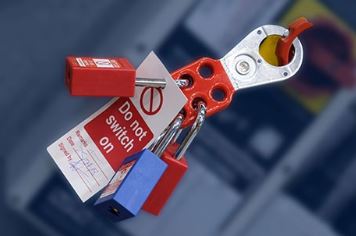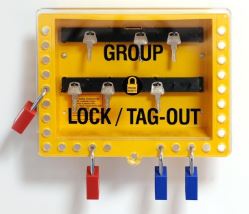Lock Out Tag Out Essentials

Lock Out Tag Out Essentials
As part of a safe system of work, lock out tag out
should be employed to ensure hazardous energy has been safely isolated. When
conducting maintenance, repairs or cleaning work on any machinery and
equipment, a safe procedure should be in place to ensure stored energy has been
safely dispelled, and re-energisation does not accidentally occur. Here we have
highlighted the essentials for a lock out tag out procedure.

What
is Lock Out Tag Out
When correctly implemented and followed, a lock out
tag out procedure ensures that machinery or equipment is completely shut off,
stored energy safely isolated and re-energisation cannot occur accidentally.
Recognised as a safety standard, lock out tag out is widely implemented as part
of safety regulations and used across a variety of machinery and equipment.
Stages
of Lock Out Tag Out

The lock out tag out procedure begins with the
preparation of the equipment and the area. Workers should be made aware a lock
out procedure is about to take place to ensure they don’t accidentally attempt
to restart the equipment. The equipment is then shut down using the
manufacturers procedure.
After shut down has occurred, all energy sources
should now be isolated and devices applied to the equipment. At this point lock out devices can be
implemented by utilising padlocks from Reece Safety
and identifier tags. Stored energy should now be isolated by blocking moving parts
and inspecting for any remaining movement.
The procedure now requires the try out phase,
whereby you safely attempt to restart the equipment. If the procedure has been
implemented correctly this should not occur. After safely shutting back down,
you may now complete the desired work. After work has complete, the lock out
devices can be removed and the equipment safely restarted.
Lock
Out Tag Out Essentials
As part of the lock out procedure, there are a few
essential pieces of equipment required to ensure safe isolation. These include
the following:
Safety Padlock: A highly important aspect of lock
out tag out is having the correct locks to place on your equipment. By choosing
the correct safety padlock, specifically designed for lock out tag out, will
help to ensure a safe system of work.
Identifier Tag: Tags allow for a visual method of
identifying who applied the lock, as this is the only person during a lock out
procedure permitted to remove it. The tags often include information such as
name, type of isolation and the date of the lock out. These tags will sometimes
include photographs for easy identification.
Lockout Hasp: Vital for multi-person lock out
procedures, lock out hasps allow energy sources to be isolated by more than one
worker for a safe system of work. This means the equipment cannot be re-energised
until every worker has removed their lock from the hasp.
Key Cabinets: For padlocks with individual keys,
storing these within a key cabinet will ensure only authorised personnel can
access them. Key cabinets are also especially useful for storing the equipment
keys to prevent accidental re-energisation.
Lock Out Stations: These are highly beneficial for
storing all of your lock out equipment in one place. As lock out equipment
should not be used for any other procedures in the workplace, keeping them all
together in a secure environment can ensure they don’t become misplaced or misused.
When implementing a lock out tag out procedure in
the workplace it is vital that employees have been trained to a high standard
and that the correct equipment is on hand. Without this safety procedure, or a
high level of training, accidents in the workplace are far more likely to
occur.
Comments are closed